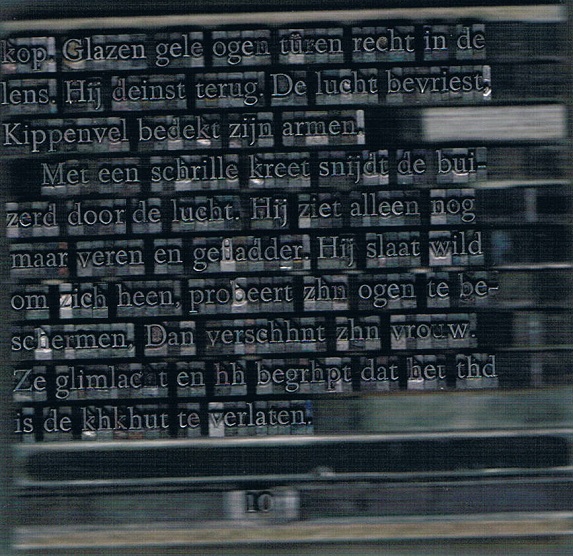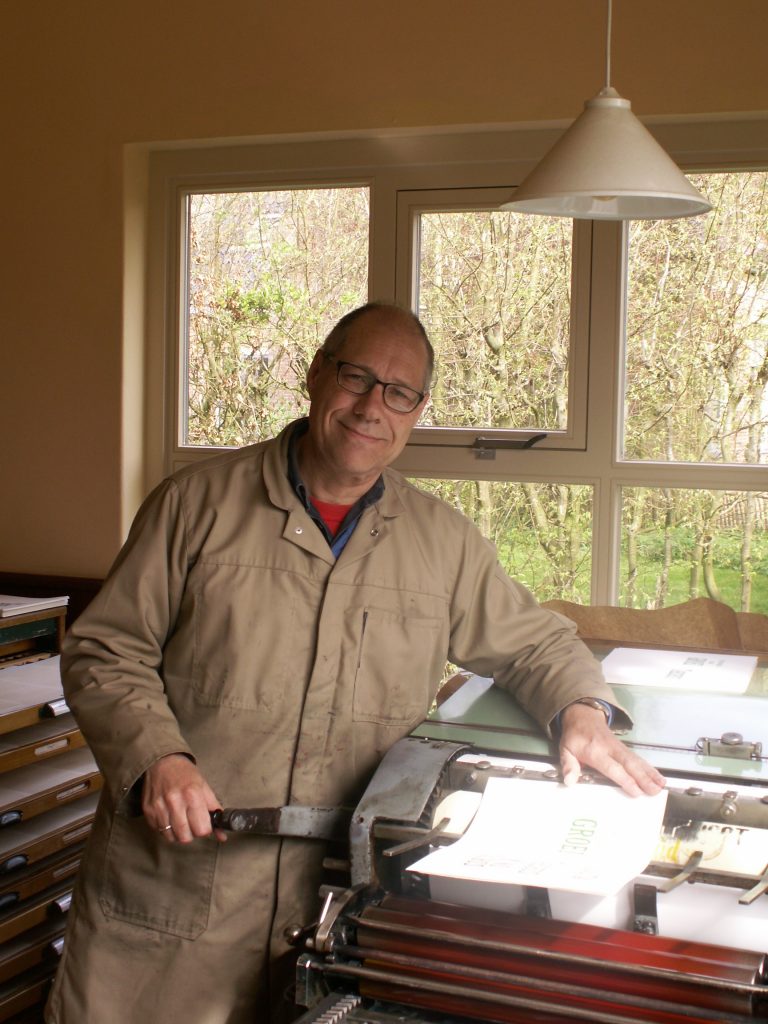'The photographer and the buzzard' is the name of my short story recently published by Triona Press. What is special about the booklet is that it was printed by hand. How do you do that? Where do you learn such an ancient craft? And can words describe what makes a hand-printed booklet special?
I asked this and more to Dick Ronner, printer and owner of Triona Press. His answers about a dying craft fascinate.
Puzzle
You were keen to publish 'The Photographer and the Buzzard', but the story could not exceed about 600 words. Why was that?
The amount of lead letters I have is limited. When you write a text of several pages, there is a moment when one letter runs out. You can find a way around that with some tricks, but when you run out of two or more letters it becomes quite a puzzle.

Rods with letters
How does manual booklet printing work?
First, I choose the size of the booklet and - relatedly - the typesetting width. Then I decide which letter I want to use for the text. Next, I set a piece by hand. This involves putting rods of letters in the right order in a typesetting hook.
When a sentence is ready, I transfer it to a galley, a plate with three raised edges. I make a proof of the typesetting of one page. If that is to my liking, I set a few more pages. Then I start printing two adjacent pages in edition. The sheets have to dry for a while, then the other side can also be printed.
Often Flora de Jong, my wife, makes a linocut to accompany the text. They are simple images with, precisely because of this, great expressiveness.
When all the sheets of a booklet are printed, I have to fold them. I then slide the pages together in the right order. Finally, I have to bind the booklets and trim them to the right size.
Time-consuming
Approximately how long are you working on it?
A booklet usually has 12 or 16 pages. I alternate manual work (typesetting, printing & binding) with other work. I also publish slimmer books, which are printed or offset printed by other companies. For these, I do the digital layout. On average, it takes me a month to produce a booklet by hand.
Where did you learn the craft?
In January 1991, I started courses in craft printing at the Graphic Centre in Groningen. It took 24 course evenings before I finished a collection of poems plus a Christmas card. I took several more courses, until the moment I got to the point where I could start printing independently in the workshop.

In the meantime, I purchased my first materials. Thus, at the end of the year 2000, I was able to open my own print shop in Houwerzijl (Northeast Groningen - OW) furnishings. I work at the back of the storefront where we started an antiquarian bookshop.
Degel presses
Can you tell something about the history of printing?
Johannes Gutenberg is considered the inventor of book printing. He was a goldsmith and almost 600 years ago came up with the idea of putting text from cast loose lead letters. Before then, text and image were cut from a wooden board. Setting was faster with loose letters, correcting became easier. After printing, the letters could be distributed and thus reused. It is extraordinary that I still work in the same way when typesetting as in the time of Johannes Gutenberg and Laurens Janszoon Coster.
In the first centuries, printing was done with platen presses. I myself use a small platen press, an Adana. With it, I can print a piece of text in postcard format. Later, cylinder presses were developed, like my Korrex proof press.
Extinct
When the printing industry switched to photo-setting and offset printing in the 1970s, a lot of material was lost. Fortunately, there were also many companies that handed over their lead and wooden typefaces and their presses to small-scale printing enthusiasts.
There are hardly any hand-printing companies left, as the work is very labour-intensive and therefore difficult to compete with modern printing techniques. Small carefully produced publications, such as poetry collections or a booklet with a short story, do find their way to enthusiasts. The same goes for a special wedding card, birth announcement card, exlibris or business card.
There are as many as more than 100 individuals in the Netherlands, who occasionally practise the craft at home or in a graphic workshop.
Liveliness makes it charming
How do you think a hand-printed booklet differs from a machine-printed one?
Lead letters you really print into the paper. I also print with old wooden letters, which used to be used for posters. You can often feel those being pressed into the paper.
I work with old material. Some letters are a bit more worn than others, so the text does not look as tight as a text printed or produced in offset. That liveliness of the print makes the text charming.
